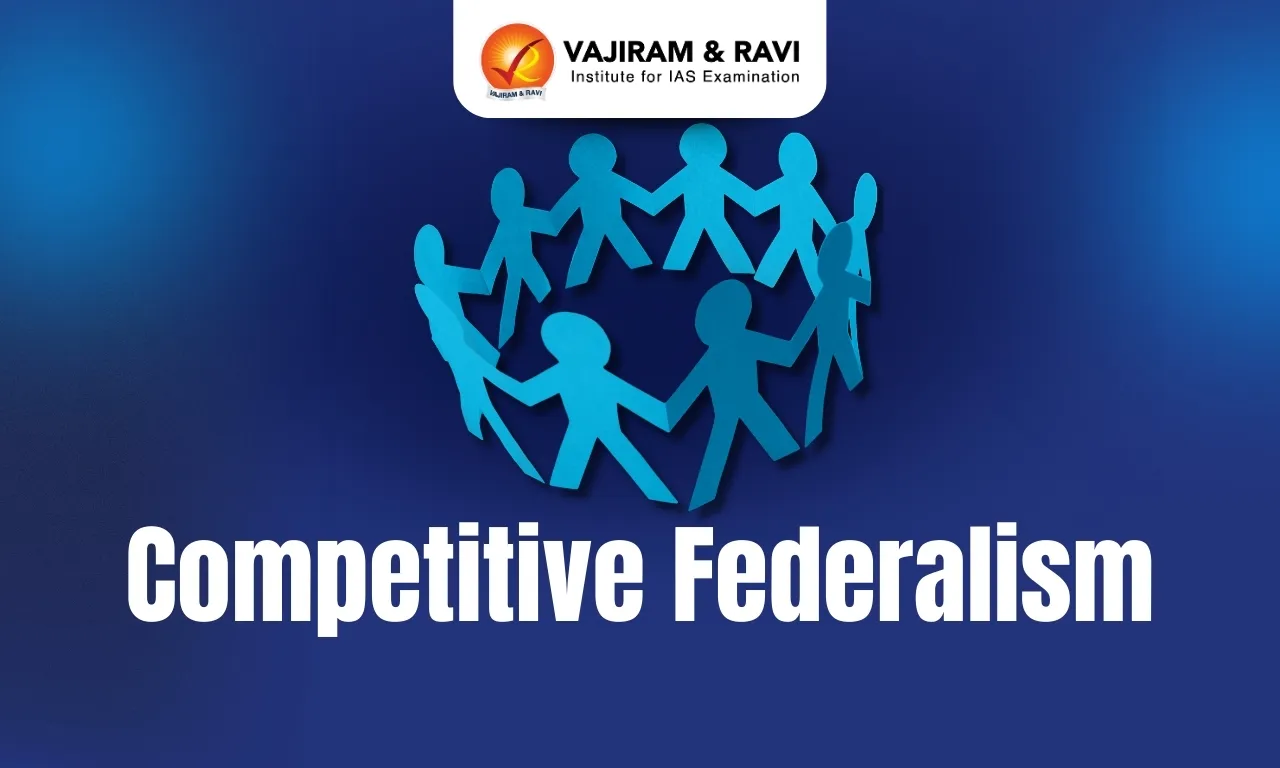- Competition among governments is a dynamic process whereby subnational governments compete with each other to attract resources, such as foreign investment or skilled workers, etc.
- Such competition is likely to occur in a federal system characterized by decentralization, by the substantial self-governing authority with both state and central government.
What is the need for Competitive Federalism in India?
The notion of competitive federalism is a relatively newer concept in Indian Polity. The Constitution of India originally comprised implicit provisions of cooperative federalism only like the Inter-state council, Zonal council, and 7th schedule.- But in the course of time, States started competing to attract capital and Investment post the LPG reforms.
- Hence, the need for Competitive capitalism has arisen to facilitate and stimulate economic activity and improve administrative efficiency.
- Competitive federalism ensures minimum waste and maximum resource usage by stimulating healthy competition among states in creating physical and social infrastructure.
Factors Contributing to Competitive Federalism in India
- Devolution of powers: The devolution of powers has allowed states to implement policies that suit their specific needs and aspirations, creating a competitive environment where states compete to attract investment.
- Economic liberalization: Economic liberalization policies of the 1990s opened up the Indian economy, and states were given greater autonomy to attract investment.
- Fiscal federalism: Fiscal federalism has contributed to competitive federalism by providing states with the necessary resources to implement policies that attract investment.
- Technology: Technology has played a significant role in fostering competitive federalism by providing states with the means to showcase their strengths and attract investment.
- Education and Skill Development: Some states have invested in education and skill development and have a more skilled workforce, and are better positioned to attract knowledge-based industries.
What are the Manifestations of Competitive Federalism in India?
Competitive Federalism - Between Centre-States
- Social welfare schemes: The Centre and states compete to offer better social welfare schemes, such as the Centre's Ayushman Bharat scheme and state-level schemes like Tamil Nadu's "Chief Minister's Comprehensive Health Insurance Scheme" to improve the standard of living.
- Agriculture policies: The Centre and states compete to implement better agricultural policies and schemes to improve agricultural production. PM-KISAN is the income support scheme of the central government, while Rythu Bandhu and Rythu Bharosa are the schemes of Telangana and Andhra Pradesh, respectively.
Competitive Federalism - Between States
- Para-Diplomacy: Also known variously as ‘state diplomacy’ or ‘regional diplomacy‘, para-diplomacy deals with the foreign policy capacity of state governments.
- Globalization and economic liberalization in the 1990s played a significant role in bringing the practice of paradiplomacy to the fore.
- States are undertaking diplomatic measures in areas of trade, commerce, foreign direct investment (FDI), education, cultural exchanges, etc.
- Gujarat, for example, organized the ‘Vibrant Gujarat Global Investors Summit’ to attract foreign investment.
- Competition in Tourism Industry: States are competing with each other to attract tourism, with each state promoting its own unique cultural and natural attractions and working to improve the infrastructure and services available to tourists.
- Investment promotion: States compete with each other to attract investment by offering incentives like tax holidays, land acquisition, and subsidies.
- For instance, at the recently held Global investors' Summit (March 2023), the state of Andhra Pradesh received an investment of Rs 13 lakh crore across 20 sectors.
- Infrastructure development: States are investing in infrastructure development to attract investment and improve their competitiveness.
- For example, projects like the Delhi-Mumbai Industrial Corridor and Vizag-Chennai Industrial Corridor (VCIC) projects are joint initiatives between the central and state governments aimed at developing industrial zones.
- Innovation and entrepreneurship: States are encouraging innovation and entrepreneurship by providing incentives to startups and small businesses.
- For example, the Telangana government launched the T-Hub initiative to promote startups, while the Kerala government launched the Kerala Startup Mission (KSUM) initiative to support entrepreneurs.
Measures Taken to Promote Competitive Federalism
Role of Union government
- States indices: The Centre also gives various indices that promote competition among the states. Some of them include
- Good Governance Index: Prepared by the Department of Administrative Reforms and Public Grievances (DARPG), this index framework covers 10 sectors and 58 indicators.
- State Ranking Index for NFSA: Prepared by the Ministry of Consumer Affairs, Food & Public Distribution to document the status and progress of implementing the National Food Security Act across the states and UTs.
- Financial incentives: The central government has announced various financial incentives for states that perform well in different sectors. For example, the Ministry of Urban Development announced the Atal Mission for Rejuvenation and Urban Transformation (AMRUT) scheme to provide financial assistance to cities based on their performance in urban development.
- One Nation One Ration Card: The scheme enables the portability of ration cards, which means that beneficiaries can access their entitlements anywhere in the country. This promotes competition among the states to improve their implementation of the scheme.
Role of Finance Commission
- The 15th Finance Commission used criteria like Demographic Performance, Tax and fiscal efforts, Forest and Ecology, etc, for the distribution of central taxes among states for the 2021-26 period.
- FFC recommended extra annual borrowing worth 0.5% of GSDP to states for a four-year period from 2021-22 to 2024-25 upon undertaking power sector reforms such as reduction in operational losses.
- FFC recommended performance incentives and grants to states for
- Carrying out agricultural reforms.
- Amending the land-related laws along the lines of NITI Aayog’s model law.
- Growth in agricultural exports.
- Maintaining and augmenting groundwater stock.
Role of NITI Aayog
NITI Aayog endeavors to promote competitive federalism by facilitating the improved performance of States/UTs.- It encourages healthy competition among states through transparent rankings, in various sectors, along with a hand-holding approach.
- Some of the indices launched by NITI Aayog are-
- School Education Quality Index
- State Health Index
- Composite Water Management Index
- Sustainable Development Goals Index
- India Innovation Index
- Export Competitiveness Index
- The ranking of States in various social sectors based on quantitative objective criteria encourages them, and even districts, to improve their performance.
- NITI Aayog also releases delta rankings for the performance of Aspirational Districts every month.
What are the factors that hinder the spirit of Competitive Federalism in India?
- Resource disparities: States with lower per capita income and weaker tax bases are often unable to compete with richer states, as they lack the resources to invest in infrastructure, education, and other key areas.
- Issue with the divisible pool of tax: The widening trust deficit and shrinkage of the divisible pool has plagued the Centre-State relation and has made cooperation and competition among them difficult.
- Regulatory hurdles: Regulatory hurdles can also be a hindrance to competitive federalism. States may face regulatory hurdles that prevent them from competing with other states in certain sectors.
- Competitive advantage: Some states have favorable factors such as skilled labor, infrastructure, and capital which makes them the sole destination for investments. Encouraging competitive patterns of investment under such situations will augment the already present inequalities.
- Lack of coordination: States may pursue their own interests without considering the impact of their actions on other states. This can lead to a situation where states engage in a race to the bottom by lowering taxes and providing excessive incentives to attract investments.
What are the measures required to promote Competitive Federalism in India?
The Central Government in India can play an important role in promoting competitive federalism among the states by taking several measures, some of which are:- Promoting collaboration and sharing of best practices: The rejuvenation of inter-state council under Article 263 will provide a forum to inquire and to resolve the disputes that negate the competition.
- Autonomy to the states: Greater autonomy has to be provided to States with regard to subjects of the Concurrent List to further enhance healthy competition.
- Allocation of funds: The Central Government can allocate funds to the states based on their performance in different areas such as infrastructure, education, healthcare, and ease of doing business.
- Capacity building: The Central Government can provide capacity-building support to the states to improve their governance, policy formulation, and implementation capabilities.
- Standardization and benchmarking: The Central Government can establish standards and benchmarks for different sectors and encourage states to meet these standards.
- Competitive Cooperative Federalism: The combination of cooperation and competition ensures that the states not only compete with each other to become the best in their respective states but also seek the support they need.
Last updated on November, 2025
→ Check out the latest UPSC Syllabus 2026 here.
→ Join Vajiram & Ravi’s Interview Guidance Programme for expert help to crack your final UPSC stage.
→ UPSC Mains Result 2025 is now out.
→ UPSC Notification 2026 is scheduled to be released on January 14, 2026.
→ UPSC Calendar 2026 is released on 15th May, 2025.
→ The UPSC Vacancy 2025 were released 1129, out of which 979 were for UPSC CSE and remaining 150 are for UPSC IFoS.
→ UPSC Prelims 2026 will be conducted on 24th May, 2026 & UPSC Mains 2026 will be conducted on 21st August 2026.
→ The UPSC Selection Process is of 3 stages-Prelims, Mains and Interview.
→ UPSC Result 2024 is released with latest UPSC Marksheet 2024. Check Now!
→ UPSC Prelims Result 2025 is out now for the CSE held on 25 May 2025.
→ UPSC Toppers List 2024 is released now. Shakti Dubey is UPSC AIR 1 2024 Topper.
→ UPSC Prelims Question Paper 2025 and Unofficial Prelims Answer Key 2025 are available now.
→ UPSC Mains Question Paper 2025 is out for Essay, GS 1, 2, 3 & GS 4.
→ UPSC Mains Indian Language Question Paper 2025 is now out.
→ UPSC Mains Optional Question Paper 2025 is now out.
→ Also check Best IAS Coaching in Delhi
Competitive Federalism FAQs
Q1. What is the Composite Water Management Index?+
Q2. What is the Sustainable Development Goals Index?+
Tags: competitive federalism quest

















